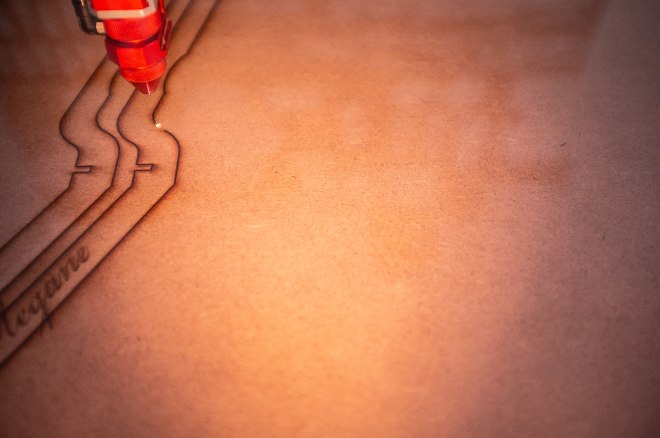From purely decorative to informative, wood engraving is a practice that has been in use for millennia. Although there is no definitive evidence suggesting when wood was first used as a medium for communication or art, many historians believe it is likely to have stemmed from Ancient Egypt. It was also used in China long before making its way to Europe in the 14th Century.
It wasn’t until the 14th Century that wood engraving as we know it now became common practice and was developed and used more widely in England in the 18th Century.
In the 1970s the biggest change to wood engraving and wood cutting occurred with the emergence of laser wood engraving.
What Is Laser Engraving?
Laser engraving is a process where the surface of a material, such as wood, is burned off by a laser beam to create patterns, words or images.
Although laser wood engraving is faster and cheaper than traditional methods of engraving, some people still opt for hand-engraved items.
The difference between wood cutting and wood engraving is down to the piece of wood rather than a difference in method. Engraving is going along the grain (wood cutting) or against the grain (wood engraving).
Preparing Wood For Engraving
To get the best results from your engraving project, the following preparations could be considered.
Masking
The smoke that is created by the burning process can mark or stain the wood. To prevent this, you can cover the piece of wood with masking tape. This papery tape will not affect the engraving process, as it burns less easily, and the paper can just be peeled off afterwards.
Presets
Different styles of engraving and thicknesses of wood will require different settings. The laser will probably have some suggestions already input, but to save you time and potential mistakes it is a good idea to save them both on the laser and your computer with a relevant name to you or the specific project.
Test Cuts
It is always a good idea to do a test cut on a scrap piece of wood before you begin engraving. This will ensure you have the right settings and enable you to troubleshoot any problems that arise without the risk of damaging your project.
The Best Woods for Laser Engraving
It is important to make sure you choose the right wood for the job or are at least aware of the properties of the wood you are using. Hardwoods are more difficult to burn than softwoods and wood with a high resin content (oak, ash, walnut) creates a darker and therefore more obvious burn. Wood with a lower resin content (pine, cedar, yew) creates a lighter, more delicate shade when burnt.
It is also important to consider the colour of the wood and how clearly the engraving will show up. The lighter the wood the greater the contrast and therefore the more obvious your lettering or pattern will be. On very dark wood (mahogany, walnut) the engraving may be less obvious than lighter woods (beech, birch).
Natural wood is, by its very nature, not uniform. Colours and textures vary and so does the way the wood responds to or takes the burning process. This can result in unexpected or mismatched effects. For more consistent and reliably even effects, good quality plywood can be a good option.
The Main Steps For Wood Engraving
- Choose the right wood for the job.
- Decide on the text or image you want to engrave.
- Ensure the image or text is saved on software that is compatible with your laser cutting machine.
- Upload the image or text to the machine.
- Double-check the size and dimensions of the image and the wood to be engraved. Remember the saying: measure twice, cut once!
- Adjust the settings on the machine for the right material/depth.
- Select the type of engraving you are using: raster (pixel by pixel) or vector (line drawing).
- Place the wood in the centre of the cutting area.
- Set the lens height, if required (some machines will do this automatically).
- Don’t forget to turn on the extractor to safely remove the dust, fumes and smoke.
This guide should help you get the best results from your wood engraving project. However, if you need further professional advice or would like us to engrave something special for you, please get in touch with us at Furnells by calling 0208 880 2070 or 0208 880 2771.

